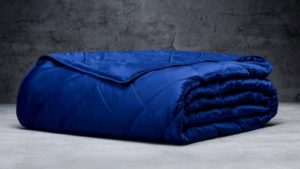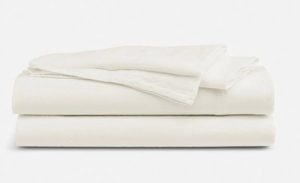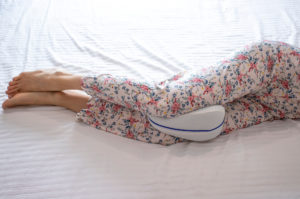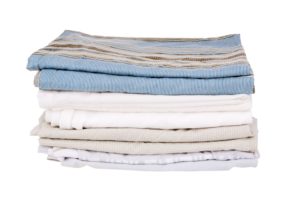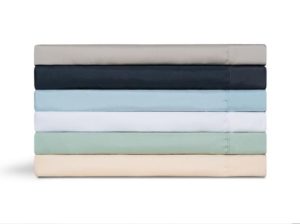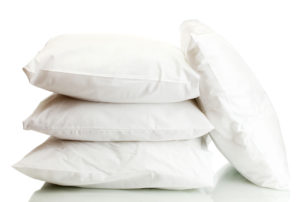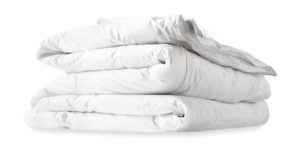How to Wash a Down Comforter
Made with high-quality materials that create an insulating feel, down comforters are a popular bedding choice for many types of sleepers. However, cleaning them isn’t always a straightforward process. If you use your down comforter with a flat sheet or duvet cover, you may only need to clean it once or twice a year. Still, it’s important to know how to do it the right way.
We’ll discuss best practices for washing a down comforter and provide additional tips for stain removal and drying.
Washing a Down Comforter: Preparation
Proper preparation can help simplify the process of cleaning a down comforter.
While down is a durable material, it’s still important to use the right kind of washing machine and detergent. Avoiding hot water and harsh chemicals also protects the comforter, and gentle care can prevent the fill from clumping or tearing.
What You’ll Need and Want to Avoid
Down fill consists of the soft fibers beneath the tough, quilled, outer feathers of ducks and geese. Down provides these birds with lightweight insulation against the elements, which is why comforters made with it are effective at keeping you warm. Maintaining the light, fluffy structure of down is key to retaining its temperature-regulating capability, so it’s important to use materials and processes that will clean your comforter safely while avoiding anything that might damage it.
| What You’ll Need: | |
|---|---|
| Front-Loading Washing Machine | Down comforters can wrap around the agitators of top-loading washing machines. Once twisted, the comforter can wash unevenly or stretch and tear. Using a large-capacity, front-loading washing machine can help you avoid this issue. You’ll want to load your comforter carefully, ensuring that it’s evenly and loosely distributed around the drum. |
| Pre-Treatment | If your comforter has stains, you may want to pre-treat them with a down-safe detergent or stain-removing solution. Attempt to lift the fabric from the fill to avoid getting it wet and apply a small amount of detergent to the stain. Rub the stained area gently and let it soak for 10 to 20 minutes. |
| Gentle Laundry Detergent | Select a gentle laundry detergent specifically designed to be used with down, such as Woolite. These detergents cleanse the down fibers, removing odors and dirt buildup without the use of harsh chemicals. |
| What to Avoid: | |
|---|---|
| Strong Laundry Detergents | Sulfates, dyes, synthetic fragrances, and other chemicals can damage down fibers and reduce the effectiveness of the comforter. |
| Chlorine Bleach | You should never use chlorine bleach on down comforters. Like other harsh chemicals, bleach can damage down, reducing its loft or even causing the fibers to disintegrate. |
| Fabric Softeners | Using fabric softener typically softens your laundry, but using it on a down comforter can cause damage. When fabric softener coats down fibers, it can cause them to clump together and flatten, which lessens their insulating capabilities. |

How to Wash a Down Comforter: Step-by-Step Breakdown
There are a few simple steps you can take to make sure your comforter comes out clean.
1. Determine what washing machine you’ll use. Many at-home machines are too small to wash comforters that are meant for mattresses larger than a twin. Additionally, top-loading washing machines can potentially damage down comforters.In either case, you may want to find a laundromat with a large-capacity washing machine. This will simplify the cleaning process and make it easier for your comforter to get a thorough, even wash.
2. Prior to loading the comforter into the washing machine, check for stains and pre-treat them. Be careful not to soak the fill.
3. Carefully load the comforter into the washing machine. Make sure that it’s not folded, twisted, or bunched.
4. Use a small amount of gentle, down-safe detergent. Too much detergent can cause the down fibers to stick together, requiring several rounds of rinsing.
5. Select the machine’s gentle or delicate cycle and warm water setting. Allow the full cycle to run. Consider adding an extra rinse cycle to ensure no detergent remains on the down.
How to Hand Wash a Down Comforter
If you don’t have access to a suitable washing machine, you may want to hand-wash your down comforter.
1. Decide where you’ll wash your comforter. A clean bathtub is ideal, but a large sink can also work. Make sure you have access to warm water.
2. Check the comforter for stains and pre-treat them. After rubbing the stained area, let the detergent sit for 10 to 20 minutes.
3. Fill the tub or sink with warm water and add a small amount of gentle, down-safe detergent. Mix the detergent in the water.
4. Gently press the comforter into the water and lightly agitate it with your hands. Do not twist or wring the comforter, as it can cause damage.
5. Let the comforter soak for 15 to 30 minutes.
6. Drain the tub or sink while pressing down on the comforter to remove excess water. Consider repeating the process without using detergent. The added rinse can help remove the detergent.
How to Dry a Down Comforter: Step-by-Step Breakdown
Once you’ve washed your comforter, it’s important to dry it thoroughly. Down that remains damp can carry an unpleasant odor and clump together. Left long enough, it may develop mildew.
1. Decide where you will dry your down comforter. If you’re using a dryer, make sure it’s large enough to accommodate your comforter. Queen or king sized comforters dry best in a large-capacity dryer that allows plenty of room for the heated air to circulate. If you use a line or rack to dry your comforter, it’s best to dry it on a warm, sunny day.
2. Add the comforter to the dryer, avoiding excessive folding or bunching. Refrain from using a dryer sheet, as they can contain fabric softeners. To help fluff the comforter and keep it from bunching together, try adding wool dryer balls.
3. Select the lowest heat setting and press start. Depending on the size of your comforter, it may take two to four hours for the down to dry completely. Avoid using a higher heat setting, as high temperatures can damage down.
Tips for Machine Drying:
- Use wool dryer balls: Wool dryer balls can help speed the drying process. Not only do they retain heat from the dryer and absorb excess moisture, wool dryer balls also gently bounce into the comforter as the dryer rotates. This helps soften the fabric and prevent the down from clumping, increasing air flow through the wet fibers. A similar effect can be achieved by tennis balls.
- Remove and shake the comforter: Remove the comforter from the dryer to shake it periodically. Once every 30 minutes is a good rule of thumb. This helps loosen any clumps that may have formed and allows air to circulate through the wet fibers, speeding up the drying process.
- Check for dampness and odors: Each time you remove your comforter from the dryer, check for dampness and the distinctive odor of wet down. Your comforter is completely dry when you’re unable to detect moisture or an odor. The comforter should feel light and free of any clumps.
Line and Rack Drying Tips
Drying a down comforter exclusively on a line or rack is not recommended. Depending on weather conditions, it may take a long time. Even then, the comforter may not dry completely, which can lead to mildew. If you choose this method, you’ll need to be patient and diligent to ensure your comforter dries thoroughly.
It’s best to dry your comforter on a warm, sunny day, preferably when there’s a breeze. Avoid wet, cold, cloudy, or extremely humid conditions. Position the comforter so that as much surface area as possible is exposed to the sun and wind.
As with machine drying, you should regularly shake the comforter out. If your comforter is large, you may need another person to help you with this.
When returning the comforter to the rack or line, rotate it if necessary so that all sides receive equal exposure to the sun. Repeat until dry.
You can also use a machine for the majority of the drying and then complete the process on a rack or line. The sun kills any remaining dust mites, while outside air helps freshen the comforter’s scent.
How Often Should You Wash a Down Comforter?
How often you need to wash your down comforter depends on how frequently it comes into direct contact with you. Using a top sheet or duvet cover can help prevent dust, dirt, body oils, sweat, and other buildup from accumulating on your comforter. This sheet or duvet cover should be washed frequently, while the comforter may only need a thorough cleaning once a year.
Spot Cleaning Tips
Occasionally, your down comforter may just need a spot cleaning instead of an entire wash. To treat a stain, first push the down fibers away from the affected area to avoid getting them wet. Next, apply stain remover, gently rubbing the fabric or scrubbing the stain with a toothbrush.
Let the stain remover sit for at least 20 minutes. Use a damp cloth to blot the fabric until the stain disappears. Repeat the process if necessary.
Once the stain is gone, use a dry cloth to remove as much moisture as possible from the comforter with careful blotting. Find a warm, sunny spot to hang the comforter on a rack or clothesline to allow for airflow. Once the comforter is completely dry, shake it out before returning it to your bed.
Can You Dry Clean a Down Comforter?
Dry cleaning a down comforter is not advisable because the harsh chemicals may damage the down. Having your comforter professionally laundered instead of dry cleaned avoids this, as the process does not include the same chemicals.

Still have questions? Ask our community!
Join our Sleep Care Community — a trusted hub of sleep health professionals, product specialists, and people just like you. Whether you need expert sleep advice for your insomnia or you’re searching for the perfect mattress, we’ve got you covered. Get personalized guidance from the experts who know sleep best.





















